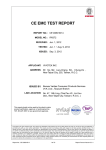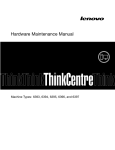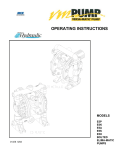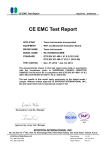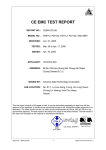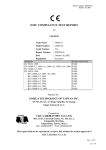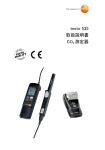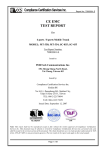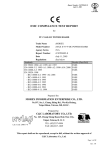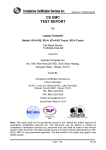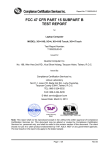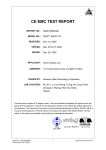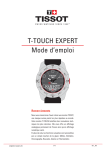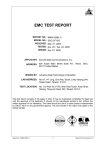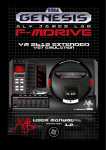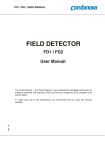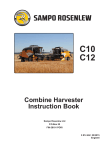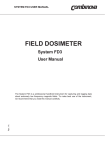Download Equipment : ADAPTER Test Model No. : 41A9734 FRU P/N
Transcript
Equipment : ADAPTER Test Model No. : 41A9734 FRU P/N: 41A9732 (Brand Name: lenovo), PA-1121-04(Brand Name: LITEON, TOSHIBA) Multiple Listing : PA-1121-04XX (The “X” in the models could be defined as 0-9, A-Z, - or blank for marketing differentiation.) Applicant : Lite-On Technology Corporation Test Report No. : CE961112A03 We, Advance Data Technology Corp., declare that the equipment above has been tested in our facility and found compliance with the requirement limits of applicable standards. The test record, data evaluation and Equipment Under Test (EUT) configurations represented herein are true and accurate under the standards herein specified. EN 55022: 2006, Class B EN 55024: 1998+A1: 2001+A2: 2003 EN 61000-3-2: 2006, Class D IEC 61000-4-2: 2001 ED.1.2 EN 61000-3-3:1995+A1:2001+A2:2005 IEC 61000-4-3: 2006 ED.3.0 IEC 61000-4-4: 2004 ED.2.0 CISPR 22: 2005, Class B IEC 61000-4-5: 2005 ED.2.0 AS/NZS CISPR 22: 2006, Class B IEC 61000-4-6: 2006 ED.2.2 IEC 61000-4-8: 2001 ED.1.1 IEC 61000-4-11: 2004 ED.2.0 In accordance with the council directive 2004/108/EC. Kenny Meng / Deputy Manager Linkou EMC / RF Lab. ADT CORP. No. 47, 14th Ling, Chia Pau Tsuen, Lin Kou Hsiang, Taipei Hsien, 244 Taiwan, R.O.C. Tel: 886-2-26052180 Fax: 886-2-26051924 http://www.adt.com.tw E-Mail: [email protected] CE EMC TEST REPORT REPORT NO.: CE961112A03 MODEL NO.: PA-1121-04XX, 41A9734 FRU P/N: 41A9732 RECEIVED: Nov. 12, 2007 TESTED: Nov. 13 ~ 15, 2007 ISSUED: Nov. 17, 2007 APPLICANT: Lite-On Technology Corporation ADDRESS: 90,Chien I Road, Chung Ho, Taipei Hsien, Taiwan, R.O.C. ISSUED BY: Advance Data Technology Corporation LAB LOCATION: No. 47, 14th Ling, Chia Pau Tsuen, Lin Kou Hsiang 244, Taipei Hsien, Taiwan, R.O.C. This test report consists of 66 pages in total. It may be duplicated completely for legal use with the approval of the applicant. It should not be reproduced except in full, without the written approval of our laboratory. The client should not use it to claim product endorsement by TAF, A2LA or any government agencies. The test results in the report only apply to the tested sample. Report No.: CE961112A03 1 Report Format Version 2.0.9 Table of Contents 1 CERTIFICATION ............................................................................................. 5 2 2.1 SUMMARY OF TEST RESULTS..................................................................... 7 MEASUREMENT UNCERTAINTY .................................................................. 9 3 3.1 3.2 3.3 3.4 3.4.1 3.4.2 GENERAL INFORMATION ........................................................................... 10 GENERAL DESCRIPTION OF EUT.............................................................. 10 DESCRIPTION OF TEST MODES................................................................ 10 GENERAL DESCRIPTION OF APPLIED STANDARDS ................................11 DESCRIPTION OF SUPPORT UNITS.......................................................... 12 FOR EMISSION TEST .................................................................................. 12 FOR HARMONICS / FLICKER / IMMUNITY TEST ....................................... 13 4 4.1 4.1.1 4.1.2 4.1.3 4.1.4 4.1.5 4.1.6 4.1.7 4.1.8 4.2 4.2.1 4.2.2 4.2.3 4.2.4 4.2.5 4.2.6 4.2.7 4.3 4.3.1 4.3.2 4.3.3 4.3.4 4.3.5 4.3.6 4.3.7 4.4 4.4.1 4.4.2 4.4.3 4.4.4 4.4.5 4.4.6 EMISSION TEST........................................................................................... 14 CONDUCTED EMISSION MEASUREMENT ................................................ 14 LIMITS OF CONDUCTED EMISSION MEASUREMENT.............................. 14 TEST INSTRUMENTS .................................................................................. 14 TEST PROCEDURE ..................................................................................... 15 DEVIATION FROM TEST STANDARD ......................................................... 15 TEST SETUP ................................................................................................ 15 EUT OPERATING CONDITIONS.................................................................. 15 TEST RESULTS (1) ...................................................................................... 16 TEST RESULTS (2) ...................................................................................... 18 RADIATED EMISSION MEASUREMENT ..................................................... 20 LIMITS OF RADIATED EMISSION MEASUREMENT................................... 20 TEST INSTRUMENTS .................................................................................. 20 TEST PROCEDURE ..................................................................................... 21 DEVIATION FROM TEST STANDARD ......................................................... 21 TEST SETUP ................................................................................................ 22 EUT OPERATING CONDITIONS.................................................................. 22 TEST RESULTS............................................................................................ 23 HARMONICS CURRENT MEASUREMENT ................................................. 25 LIMITS OF HARMONICS CURRENT MEASUREMENT............................... 25 TEST INSTRUMENTS .................................................................................. 25 TEST PROCEDURE ..................................................................................... 26 DEVIATION FROM TEST STANDARD ......................................................... 26 TEST SETUP ................................................................................................ 26 EUT OPERATING CONDITIONS.................................................................. 26 TEST RESULTS............................................................................................ 27 VOLTAGE FLUCTUATION AND FLICKS MEASUREMENT ......................... 28 LIMITS OF VOLTAGE FLUCTUATION AND FLICKS MEASUREMENT ....... 28 TEST INSTRUMENTS .................................................................................. 28 TEST PROCEDURE ..................................................................................... 28 DEVIATION FROM TEST STANDARD ......................................................... 29 TEST SETUP ................................................................................................ 29 EUT OPERATING CONDITIONS.................................................................. 29 Report No.: CE961112A03 2 Report Format Version 2.0.9 4.4.7 TEST RESULTS............................................................................................ 30 5 5.1 5.2 5.3 5.4 5.4.1 5.4.2 5.4.3 5.4.4 5.4.5 5.4.6 5.5 IMMUNITY TEST .......................................................................................... 31 GENERAL DESCRIPTION............................................................................ 31 GENERAL PERFORMANCE CRITERIA DESCRIPTION ............................. 32 EUT OPERATING CONDITION .................................................................... 32 ELECTROSTATIC DISCHARGE IMMUNITY TEST (ESD)............................ 33 TEST SPECIFICATION................................................................................. 33 TEST INSTRUMENTS .................................................................................. 33 TEST PROCEDURE ..................................................................................... 33 DEVIATION FROM TEST STANDARD ......................................................... 34 TEST SETUP ................................................................................................ 35 TEST RESULTS............................................................................................ 36 RADIATED, RADIO-FREQUENCY, ELECTROMAGNETIC FIELD IMMUNITY TEST (RS)..................................................................................................... 37 TEST SPECIFICATION................................................................................. 37 TEST INSTRUMENTS .................................................................................. 37 TEST PROCEDURE ..................................................................................... 38 DEVIATION FROM TEST STANDARD ......................................................... 38 TEST SETUP ................................................................................................ 39 TEST RESULTS............................................................................................ 40 ELECTRICAL FAST TRANSIENT/BURST IMMUNITY TEST (EFT) ............. 41 TEST SPECIFICATION................................................................................. 41 TEST INSTRUMENTS .................................................................................. 41 TEST PROCEDURE ..................................................................................... 41 DEVIATION FROM TEST STANDARD ......................................................... 42 TEST SETUP ................................................................................................ 42 TEST RESULTS............................................................................................ 43 SURGE IMMUNITY TEST............................................................................. 44 TEST SPECIFICATION................................................................................. 44 TEST INSTRUMENTS .................................................................................. 44 TEST PROCEDURE ..................................................................................... 45 DEVIATION FROM TEST STANDARD ......................................................... 45 TEST SETUP ................................................................................................ 45 TEST RESULTS............................................................................................ 46 IMMUNITY TO CONDUCTED DISTURBANCES INDUCED BY RF FIELDS (CS) 47 TEST SPECIFICATION................................................................................. 47 TEST INSTRUMENTS .................................................................................. 47 TEST PROCEDURE ..................................................................................... 48 DEVIATIN FOR TEST STANDARD ............................................................... 48 TEST SETUP ................................................................................................ 49 TEST RESULTS............................................................................................ 50 POWER FREQUENCY MAGNETIC FIELD IMMUNITY TEST...................... 51 TEST SPECIFICATION................................................................................. 51 TEST INSTRUMENTS .................................................................................. 51 TEST PROCEDURE ..................................................................................... 51 DEVIATION FROM TEST STANDARD ......................................................... 52 TEST SETUP ................................................................................................ 52 5.5.1 5.5.2 5.5.3 5.5.4 5.5.5 5.5.6 5.6 5.6.1 5.6.2 5.6.3 5.6.4 5.6.5 5.6.6 5.7 5.7.1 5.7.2 5.7.3 5.7.4 5.7.5 5.7.6 5.8 5.8.1 5.8.2 5.8.3 5.8.4 5.8.5 5.8.6 5.9 5.9.1 5.9.2 5.9.3 5.9.4 5.9.5 Report No.: CE961112A03 3 Report Format Version 2.0.9 5.9.6 5.10 5.10.1 5.10.2 5.10.3 5.10.4 5.10.5 5.10.6 TEST RESULTS............................................................................................ 53 VOLTAGE DIP/SHORT INTERRUPTIONS/VOLTAGE VARIATIONS (DIP) IMMUNITY TEST .......................................................................................... 54 TEST SPECIFICATION................................................................................. 54 TEST INSTRUMENTS .................................................................................. 54 TEST PROCEDURE ..................................................................................... 54 DEVIATION FROM TEST STANDARD ......................................................... 54 TEST SETUP ................................................................................................ 55 TEST RESULTS............................................................................................ 56 6 PHOTOGRAPHS OF THE TEST CONFIGURATION.................................... 57 7 APPENDIX - INFORMATION ON THE TESTING LABORATORIES............. 66 Report No.: CE961112A03 4 Report Format Version 2.0.9 1 CERTIFICATION PRODUCT: ADAPTER MODEL NO.: PA-1121-04XX(Brand Name: LITEON, TOSHIBA) (The “X” in the models could be defined as 0-9, A-Z, - or blank for marketing differentiation.) APPLICANT: TESTED: TEST ITEM: STANDARDS: 41A9734 FRU P/N: 41A9732 (Brand Name: lenovo) Lite-On Technology Corporation Nov. 13 ~ 15, 2007 ENGINEERING SAMPLE EN 55022: 2006, Class B EN 55024: 1998+A1: 2001 EN 61000-3-2: 2006, Class D +A2: 2003 EN 61000-3-3: 1995+A1: 2001 IEC 61000-4-2: 2001 ED.1.2 +A2: 2005 IEC 61000-4-3: 2006 ED.3.0 IEC 61000-4-4: 2004 ED.2.0 IEC 61000-4-5: 2005 ED.2.0 CISPR 22: 2005, Class B IEC 61000-4-6: 2006 ED.2.2 AS/NZS CISPR 22: 2006, IEC 61000-4-8: 2001 ED.1.1 Class B IEC 61000-4-11: 2004 ED.2.0 The above equipment has been tested by Advance Data Technology Corporation, and found compliance with the requirement of the above standards. Approval signature-on next page Report No.: CE961112A03 5 Report Format Version 2.0.9 CERTIFICATION-Continued The test record, data evaluation & Equipment Under Test (EUT) configurations represented herein are true and accurate accounts of the measurements of the sample’s EMC characteristics under the conditions specified in this report. PREPARED BY : , DATE: Nov. 17, 2007 , DATE: Nov. 17, 2007 , DATE: Nov. 17, 2007 , DATE: Nov. 17, 2007 (Irene Hou/ Specialist ) TECHNICAL ACCEPTANCE : Responsible for EMI TECHNICAL ACCEPTANCE ( Ken Liu / Deputy Manager ) : Responsible for EMS APPROVED BY ( Andy Cheng / Senior Engineer ) : ( Kenny Meng / Deputy Manager ) Report No.: CE961112A03 6 Report Format Version 2.0.9 2 SUMMARY OF TEST RESULTS The EUT has been tested according to the following specifications: Standard EN 55022: 2006, Class B EMISSION Test Type Result Conducted Test Meets Class B Limit PASS Minimum passing margin is –10.10 dB at 0.562 MHz Radiated Test Meets Class B Limit PASS Minimum passing margin is –2.99 dB at 219.70 MHz CISPR 22: 2005, Class B AS/NZS CISPR 22: 2006, Class B Remarks EN 61000-3-2:2006, Class D Harmonic current PASS Meets Class D Limit emissions EN 61000-3-3:1995+ A1: 2001 +A2: 2005 Voltage fluctuations & flicker Report No.: CE961112A03 PASS Meets the requirements. 7 Report Format Version 2.0.9 IMMUNITY (EN 55024: 1998+A1: 2001+A2: 2003) Standard Test Type Result Remarks Electrostatic Meets the requirements of IEC 61000-4-2: 2001 PASS discharge ED.1.2 Performance Criterion B immunity test Radiated, Meets the requirements of IEC 61000-4-3: 2006 radio-frequency, PASS Performance Criterion A ED.3.0 electromagnetic field immunity test Electrical fast Meets the requirements of IEC 61000-4-4: 2004 transient / burst PASS ED.2.0 Performance Criterion A immunity test. Meets the requirements of IEC 61000-4-5: 2005 Surge immunity PASS ED.2.0 test Performance Criterion A Immunity to conducted Meets the requirements of IEC 61000-4-6: 2006 disturbances, PASS ED.2.2 Performance Criterion A induced by radio-frequency fields Power frequency Meets the requirements of IEC 61000-4-8: 2001 magnetic field PASS ED.1.1 Performance Criterion A immunity test. IEC 61000-4-11: 2004 ED.2.0 Report No.: CE961112A03 Voltage dips, short interruptions and voltage variations immunity tests 8 Meets the requirements of Voltage Dips: i.) >95% reduction Performance Criterion A PASS ii.) 30% reduction – Performance Criterion A Voltage Interruptions: i) >95% reduction – Performance Criterion B Report Format Version 2.0.9 2.1 MEASUREMENT UNCERTAINTY Where relevant, the following measurement uncertainty levels have been estimated for tests performed on the EUT as specified in CISPR 16-4-2: This uncertainty represents an expanded uncertainty expressed at approximately the 95% confidence level using a coverage factor of k=2. Measurement Conducted emissions Uncertainty 2.45 dB Radiated emissions 3.97 dB Report No.: CE961112A03 9 Report Format Version 2.0.9 3 GENERAL INFORMATION 3.1 GENERAL DESCRIPTION OF EUT PRODUCT ADAPTER MODEL NO. PA-1121-04XX, 41A9734 FRU P/N: 41A9732 POWER SUPPLY Switching Rating: refer to the below Power Cord: Non-shielded DC (1.8 m) with one core DATA CABLE SUPPLIED N/A NOTE: 1. The EUT is an ADAPTER (AC 3Pin) with two models, which are identical with each other in all aspects except for their rating differences only, as follows : Brand LITEON TOSHIBA lenovo Model No. Rating PA-1121-04XX Ø AC I/P: 100-240V, 2.0A, 50-60Hz. Ø DC O/P: +19V/ 6.3A 41A9734 FRU P/N: 41A9732 Ø AC I/P: 100-240V, 1.8A, 50-60Hz. Ø DC O/P: +19.5V/ 6.15A Note: The “X” in the model: PA-1121-04XX could be defined as 0-9, A-Z, - or blank for marketing differentiation. 2. For a more detailed features description, please refer to the manufacturer's specifications or the User's Manual. 3.2 DESCRIPTION OF TEST MODES The EUT was tested using the above models. The worst emission level was found when tested on model no.: 41A9734 FRU P/N: 41A9732. Therefore the final test modes are as follows: Test Item Conducted Test Radiated, Harmonic, flicker, Immunity Test Report No.: CE961112A03 Test Mode Model No. Mode 1 41A9734 FRU P/N: 41A9732 Mode 2 PA-1121-04 Mode 1 41A9734 FRU P/N: 41A9732 10 Remark Full Load Report Format Version 2.0.9 3.3 GENERAL DESCRIPTION OF APPLIED STANDARDS The EUT is a kind of ITE equipment and, according to the specifications of the manufacturers, must comply with the requirements of the following standards: EN 55022: 2006,Class B EN 61000-3-2: 2006, Class D EN 61000-3-3: 1995+A1: 2001 +A2: 2005 CISPR 22: 2005, Class B AS/NZS CISPR 22: 2006, Class B EN 55024: 1998+A1: 2001+A2: 2003 IEC 61000-4-2: 2001 ED.1.2 IEC 61000-4-3: 2006 ED.3.0 IEC 61000-4-4: 2004 ED.2.0 IEC 61000-4-5: 2005 ED.2.0 IEC 61000-4-6: 2006 ED.2.2 IEC 61000-4-8: 2001 ED.1.1 IEC 61000-4-11: 2004 ED.2.0 All tests have been performed and recorded as per the above standards. Report No.: CE961112A03 11 Report Format Version 2.0.9 3.4 DESCRIPTION OF SUPPORT UNITS The EUT has been tested as an independent unit together with other necessary accessories or support units. The following support units or accessories were used to form a representative test configuration during the tests. 3.4.1 FOR EMISSION TEST NO. 1 PRODUCT DUMMY LOAD BRAND ADT MODEL NO. L19A SERIAL NO. L2-010008 FCC ID N/A Note: One non-shielded AC 3-Pin power cord (1.8m) was connected to EUT. TEST CONFIGURATION DUMMY LOAD EUT Report No.: CE961112A03 12 Report Format Version 2.0.9 3.4.2 FOR HARMONICS / FLICKER / IMMUNITY TEST NO. PRODUCT BRAND MODEL NO. SERIAL NO. FCC ID 1 DUMMY LOAD ADT L19A L2-010005 N/A 2 Multimeter YFE YF-370A N/A N/A Note: One non-shielded AC 3-Pin power cord (1.8m) was connected to EUT. Test Configuration Multimeter Report No.: CE961112A03 DUMMY LOAD 13 EUT Report Format Version 2.0.9 4 EMISSION TEST 4.1 CONDUCTED EMISSION MEASUREMENT 4.1.1 LIMITS OF CONDUCTED EMISSION MEASUREMENT TEST STANDARD: EN 55022 Class A (dBuV) Class B (dBuV) FREQUENCY (MHz) Quasi-peak Average Quasi-peak Average 0.15 - 0.5 79 66 66 - 56 56 - 46 0.50 - 5.0 73 60 56 46 5.0 - 30.0 73 60 60 50 NOTE: (1) The lower limit shall apply at the transition frequencies. (2) The limit decreases in line with the logarithm of the frequency in the range of 0.15 to 0.50 MHz. (3) All emanations from a class A/B digital device or system, including any network of conductors and apparatus connected thereto, shall not exceed the level of field strengths specified above. 4.1.2 TEST INSTRUMENTS DESCRIPTION & MODEL NO. SERIAL NO. MANUFACTURER ROHDE & SCHWARZ Test ESHS 30 828765/002 Receiver ROHDE & SCHWARZ Artificial ESH3-Z5 835239/001 Mains Network (for EUT) LISN With Adapter (for EUT) AD10 C09Ada-001 ROHDE & SCHWARZ Artificial ESH3-Z5 835239/002 Mains Network (for peripherals) Software ADT_Cond_V7.3.5 NA Software ADT_ISN_V7.3.5 NA RF cable (JYEBAO) 5D-FB Cable-C09.01 SUHNER Terminator 65BNC-5001 E1-010789 (For ROHDE & SCHWARZ LISN) CALIBRATED UNTIL Jul. 30, 2008 Feb. 26, 2008 Feb. 26, 2008 Mar. 13, 2008 NA NA Mar. 01, 2008 May 17, 2008 NOTE: 1. The calibration interval of the above test instruments is 12 months and the calibrations are traceable to NML/ROC and NIST/USA. 2. The test was performed in ADT Shielded Room No. 9. 3. The VCCI Site Registration No. C-1312. Report No.: CE961112A03 14 Report Format Version 2.0.9 4.1.3 TEST PROCEDURE a. The EUT was placed 0.4 meters from the conducting wall of the shielded room with EUT being connected to the power mains through a line impedance stabilization network (LISN). Other support units were connected to the power mains through another LISN. The two LISNs provide 50 Ohm/ 50uH of coupling impedance for the measuring instrument. b. Both lines of the power mains connected to the EUT were checked for maximum conducted interference. c. The frequency range from 150 kHz to 30 MHz was searched. Emission levels under (Limit - 20dB) were not recorded. 4.1.4 DEVIATION FROM TEST STANDARD No deviation 4.1.5 TEST SETUP V e r t ic a l G r o u n d R e fe re n c e P la n e T e s t R e c e iv e r EUT 40cm 80cm L IS N H o r iz o n t a l G r o u n d R e fe re n c e P la n e N o te : 1 .S u p p o rt u n its w e re c o n n e c te d to s e c o n d L IS N . 2 . B o t h o f L I S N s ( A M N ) a r e 8 0 c m f r o m E U T a n d a t le a s t 8 0 c m f r o m o t h e r u n it s a n d o t h e r m e t a l p l a n e s s u p p o r t u n i t s . For the actual test configuration, please refer to the related item – Photographs of the Test Configuration. 4.1.6 EUT OPERATING CONDITIONS Set the EUT on full resistor load. Report No.: CE961112A03 15 Report Format Version 2.0.9 4.1.7 TEST RESULTS (1) TEST MODE Mode 1 6dB BANDWIDTH 9 kHz INPUT POWER 230Vac, 50 Hz PHASE Line (L) ENVIRONMENTAL CONDITIONS 25deg. C, 58% RH, 1004hPa TESTED BY: Jerry Huang Freq. Corr. Reading Value [MHz] 0.150 0.349 0.474 0.645 1.189 12.689 18.479 Factor (dB) 0.30 0.30 0.30 0.30 0.30 0.96 1.24 [dB (uV)] Q.P. AV. 40.71 42.44 39.64 38.95 36.58 40.74 41.44 - No 1 2 3 4 5 6 7 Emission Level [dB (uV)] Q.P. AV. 41.01 42.74 39.94 39.25 36.88 41.70 42.68 - Limit Margin [dB (uV)] Q.P. AV. 66.00 56.00 58.99 48.99 56.44 46.44 56.00 46.00 56.00 46.00 60.00 50.00 60.00 50.00 (dB) Q.P. -24.99 -16.25 -16.50 -16.75 -19.12 -18.30 -17.32 AV. - REMARKS: 1. Q.P. and AV. are abbreviations of quasi-peak and average individually. 2. "-": The Quasi-peak reading value also meets average limit and measurement with the average detector is unnecessary. 3. The emission levels of other frequencies were very low against the limit. 4. Margin value = Emission level - Limit value 5. Correction factor = Insertion loss + Cable loss 6. Emission Level = Correction Factor + Reading Value. Report No.: CE961112A03 16 Report Format Version 2.0.9 TEST MODE Mode 1 6dB BANDWIDTH 9 kHz INPUT POWER 230Vac, 50 Hz PHASE Neutral (N) ENVIRONMENTAL CONDITIONS 25deg. C, 58% RH, 1004hPa TESTED BY: Jerry Huang Freq. Corr. Reading Value [MHz] 0.357 0.474 0.642 0.967 13.121 18.998 Factor (dB) 0.20 0.20 0.20 0.20 0.89 1.08 [dB (uV)] Q.P. AV. 38.59 37.78 38.77 37.38 40.55 41.48 - No 1 2 3 4 5 6 Emission Level [dB (uV)] Q.P. AV. 38.79 37.98 38.97 37.58 41.44 42.56 - Limit Margin [dB (uV)] Q.P. AV. 58.79 48.79 56.44 46.44 56.00 46.00 56.00 46.00 60.00 50.00 60.00 50.00 (dB) Q.P. -20.00 -18.46 -17.03 -18.42 -18.56 -17.44 AV. - REMARKS: 1. Q.P. and AV. are abbreviations of quasi-peak and average individually. 2. "-": The Quasi-peak reading value also meets average limit and measurement with the average detector is unnecessary. 3. The emission levels of other frequencies were very low against the limit. 4. Margin value = Emission level - Limit value 5. Correction factor = Insertion loss + Cable loss 6. Emission Level = Correction Factor + Reading Value. Report No.: CE961112A03 17 Report Format Version 2.0.9 4.1.8 TEST RESULTS (2) TEST MODE Mode 2 6dB BANDWIDTH 9 kHz INPUT POWER 230Vac, 50 Hz PHASE Line (L) ENVIRONMENTAL CONDITIONS 25deg. C, 58% RH, 1004hPa TESTED BY: Jerry Huang Freq. Corr. Reading Value [MHz] 0.171 0.390 0.450 0.562 0.789 1.287 12.878 Factor (dB) 0.30 0.30 0.30 0.30 0.30 0.30 0.97 [dB (uV)] Q.P. AV. 42.60 44.74 42.35 45.60 44.49 43.22 42.94 - No 1 2 3 4 5 6 7 Emission Level [dB (uV)] Q.P. AV. 42.90 45.04 42.65 45.90 44.79 43.52 43.91 - Limit Margin [dB (uV)] Q.P. AV. 64.91 54.91 58.06 48.06 56.88 46.88 56.00 46.00 56.00 46.00 56.00 46.00 60.00 50.00 (dB) Q.P. -22.01 -13.02 -14.23 -10.10 -11.21 -12.48 -16.09 AV. - REMARKS: 1. Q.P. and AV. are abbreviations of quasi-peak and average individually. 2. "-": The Quasi-peak reading value also meets average limit and measurement with the average detector is unnecessary. 3. The emission levels of other frequencies were very low against the limit. 4. Margin value = Emission level - Limit value 5. Correction factor = Insertion loss + Cable loss 6. Emission Level = Correction Factor + Reading Value. Report No.: CE961112A03 18 Report Format Version 2.0.9 TEST MODE Mode 2 6dB BANDWIDTH 9 kHz INPUT POWER 230Vac, 50 Hz PHASE Neutral (N) ENVIRONMENTAL CONDITIONS 25deg. C, 58% RH, 1004hPa TESTED BY: Jerry Huang Freq. Corr. Reading Value [MHz] 0.168 0.387 0.510 0.618 1.016 12.316 16.649 Factor (dB) 0.20 0.20 0.20 0.20 0.20 0.84 1.03 [dB (uV)] Q.P. AV. 38.82 43.64 43.22 43.70 43.80 42.62 38.07 - No 1 2 3 4 5 6 7 Emission Level [dB (uV)] Q.P. AV. 39.02 43.84 43.42 43.90 44.00 43.46 39.10 - Limit Margin [dB (uV)] Q.P. AV. 65.06 55.06 58.13 48.13 56.00 46.00 56.00 46.00 56.00 46.00 60.00 50.00 60.00 50.00 (dB) Q.P. -26.04 -14.29 -12.58 -12.10 -12.00 -16.54 -20.90 AV. - REMARKS: 1. Q.P. and AV. are abbreviations of quasi-peak and average individually. 2. "-": The Quasi-peak reading value also meets average limit and measurement with the average detector is unnecessary. 3. The emission levels of other frequencies were very low against the limit. 4. Margin value = Emission level - Limit value 5. Correction factor = Insertion loss + Cable loss 6. Emission Level = Correction Factor + Reading Value. Report No.: CE961112A03 19 Report Format Version 2.0.9 4.2 RADIATED EMISSION MEASUREMENT 4.2.1 LIMITS OF RADIATED EMISSION MEASUREMENT TEST STANDARD: EN 55022 Class A (at 10m) FREQUENCY (MHz) dBuV/m NOTE: Class B (at 10m) dBuV/m 30 – 230 40 30 230 - 1000 47 37 (1) The lower limit shall apply at the transition frequencies. (2) Emission level (dBuV/m) = 20 log Emission level (uV/m). (3) All emanations from a class A/B digital device or system, including any network of conductors and apparatus connected thereto, shall not exceed the level of field strengths specified above. 4.2.2 TEST INSTRUMENTS DESCRIPTION & MANUFACTURER ROHDE & SCHWARZ TEST RECEIVER CHASE BILOG Antenna ADT. Turn Table ADT. Tower Software ANRITSU RF Switches WOKEN RF cable MODEL NO. SERIAL NO. CALIBRATED UNTIL ESVS10 846285/012 Aug. 06, 2008 CBL6112A 2331 TT100 0201 AT100 0201 ADT_Radiate NA d_V7.6.15 MP59B M32159 8D CABLE-ST8-01 Sep. 13, 2008 NA NA NA Mar. 29, 2008 Mar. 29, 2008 NOTE: 1. The calibration interval of the above test instruments is 12 months. And the calibrations are traceable to NML/ROC and NIST/USA. 2. The test was performed in ADT Open Site No. 8. 3. The VCCI Site Registration No. R-877. Report No.: CE961112A03 20 Report Format Version 2.0.9 4.2.3 TEST PROCEDURE a. The EUT was placed on the top of a rotating table 0.8 meters above the ground at a 10-meter open field site. The table was rotated 360 degrees to determine the position of the highest radiation. b. The EUT was set 10 meters away from the interference-receiving antenna, which was mounted on the top of a variable-height antenna tower. c. The antenna is a broadband antenna, and its height is varied from one meter to four meters above the ground to determine the maximum value of the field strength. Both horizontal and vertical polarization of the antenna are set to make the measurement. d. For each suspected emission, the EUT was arranged to its worst case and then the antenna was tuned to heights from 1 meter to 4 meters and the turn table was turned from 0 degrees to 360 degrees to find the maximum reading. e. The test-receiver system was set to Peak Detect Function and Specified Bandwidth with Maximum Hold Mode. NOTE: 1. The resolution bandwidth of test receiver/spectrum analyzer is 120kHz for Quasi-peak detection (QP) at frequency below 1GHz. 4.2.4 DEVIATION FROM TEST STANDARD No deviation Report No.: CE961112A03 21 Report Format Version 2.0.9 4.2.5 TEST SETUP Ant. Tower EUT& Support Units 1-4m Variable 10m Turn Table 80cm Ground Plane Test Receiver For the actual test configuration, please refer to the related item – Photographs of the Test Configuration. 4.2.6 EUT OPERATING CONDITIONS Same as item 4.1.6 Report No.: CE961112A03 22 Report Format Version 2.0.9 4.2.7 TEST RESULTS TEST MODE Mode 1 INPUT POWER 230Vac, 50 Hz ENVIRONMENTAL 24deg. C, 66% RH, CONDITIONS 1004hPa FREQUENCY RANGE DETECTOR FUNCTION & BANDWIDTH 30-1000 MHz Quasi-Peak, 120kHz TESTED BY: Tony Lin ANTENNA POLARITY & TEST DISTANCE: HORIZONTAL AT 10 M No. Freq. (MHz) 1 2 3 4 5 6 62.51 83.37 140.24 159.56 193.45 219.70 REMARKS: Emission Level (dBuV/m) 19.75 QP 17.11 QP 20.56 QP 20.03 QP 21.61 QP 27.01 QP Limit (dBuV/m) Margin (dB) 30.00 30.00 30.00 30.00 30.00 30.00 -10.25 -12.89 -9.44 -9.97 -8.39 -2.99 Antenna Height (m) 4.00 H 4.00 H 4.00 H 4.00 H 4.00 H 4.00 H Table Angle (Degree) 245 148 133 55 71 38 Raw Value (dBuV) 14.23 8.81 7.77 8.48 10.83 14.51 Correction Factor (dB/m) 5.52 8.30 12.79 11.55 10.78 12.50 1. Emission level(dBuV/m)=Raw Value(dBuV) + Correction Factor(dB/m) 2. Correction Factor(dB/m) = Antenna Factor (dB/m) + Cable Factor (dB) 3. The other emission levels were very low against the limit. 4. Margin value = Emission level – Limit value. Report No.: CE961112A03 23 Report Format Version 2.0.9 TEST MODE Mode 1 INPUT POWER 230Vac, 50 Hz ENVIRONMENTAL 24deg. C, 66% RH, CONDITIONS 1004hPa FREQUENCY RANGE DETECTOR FUNCTION & BANDWIDTH 30-1000 MHz Quasi-Peak, 120kHz TESTED BY: Tony Lin ANTENNA POLARITY & TEST DISTANCE: VERTICAL AT 10 M No. Freq. (MHz) 1 2 3 4 5 6 46.85 71.23 110.24 150.71 178.44 216.70 REMARKS: Emission Level (dBuV/m) 16.74 QP 17.64 QP 17.85 QP 17.84 QP 19.45 QP 21.87 QP Limit (dBuV/m) Margin (dB) 30.00 30.00 30.00 30.00 30.00 30.00 -13.26 -12.36 -12.15 -12.16 -10.55 -8.13 Antenna Height (m) 1.51 V 1.37 V 1.00 V 1.00 V 1.00 V 1.00 V Table Angle (Degree) 251 222 334 4 45 188 Raw Value (dBuV) 5.11 10.85 5.53 5.91 9.21 9.57 Correction Factor (dB/m) 11.63 6.79 12.32 11.93 10.24 12.30 1. Emission level(dBuV/m)=Raw Value(dBuV) + Correction Factor(dB/m) 2. Correction Factor(dB/m) = Antenna Factor (dB/m) + Cable Factor (dB) 3. The other emission levels were very low against the limit. 4. Margin value = Emission level – Limit value. Report No.: CE961112A03 24 Report Format Version 2.0.9 4.3 HARMONICS CURRENT MEASUREMENT 4.3.1 LIMITS OF HARMONICS CURRENT MEASUREMENT TEST STANDARD: EN 61000-3-2 Limits for Class A equipment Harmonics Max. permissible Order harmonics current n A Odd harmonics 3 2.30 5 1.14 7 0.77 9 0.40 11 0.33 13 0.21 15<=n<=39 0.15x15/n Even harmonics 2 1.08 4 0.43 6 0.30 8<=n<=40 0.23x8/n Harmonics Order n 3 5 7 9 11 13 15<=n<=39 Limits for Class D equipment Max. permissible Max. permissible harmonics current per harmonics current watt mA/W A Odd Harmonics only 3.4 2.30 1.9 1.14 1.0 0.77 0.5 0.40 0.35 0.33 0.30 0.21 3.85/n 0.15x15/n NOTE: 1. Class A and Class D are classified according to section 5 of EN 61000-3-2: 2006. 2. According to section 7 of EN 61000-3-2: 2006, the above limits for all equipment except for lighting equipment are for all applications having an active input power > 75 W and no limits apply for equipment with an active input power up to and including 75 W. 4.3.2 TEST INSTRUMENTS DESCRIPTION & MANUFACTURER EMC PARTNER EMC Emission Tester Software MODEL NO. SERIAL NO. CALIBRATED UNTIL HAR1000-1P 084 Apr. 25, 2008 HARCS NA NA NOTE: 1. The test was performed in EMS Room No. 1. 2. The calibration interval of the above test instruments is 12 months and the calibrations are traceable to NML/ROC and NIST/USA. Report No.: CE961112A03 25 Report Format Version 2.0.9 4.3.3 TEST PROCEDURE a. The EUT was placed on the top of a wooden table 0.8 meters above the ground and operated to produce the maximum harmonic components under normal operating conditions for each successive harmonic component in turn. b. The classification of EUT is according to section 5 of EN 61000-3-2: 2006. c. The EUT is classified as follows: Class A: Balanced three-phase equipment, Household appliances excluding equipment as Class D, Tools excluding portable tools, Dimmers for incandescent lamps, audio equipment, equipment not specified in one of the three other classes. Class B: Portable tools. Class C: Lighting equipment, including dimming devices. Class D: Equipment having a specified power less than or equal to 600 W of the following types: Personal computers and personal computer monitors. d. The correspondent test program of test instrument to measure the current harmonics emanated from EUT is chosen. The measure time shall be not less than the time necessary for the EUT to be exercised. 4.3.4 DEVIATION FROM TEST STANDARD No deviation 4.3.5 TEST SETUP EUT For the actual test configuration, please refer to the related item – Photographs of the Test Configuration. 4.3.6 EUT OPERATING CONDITIONS Connected a resistor load to DC output port of EUT to make EUT have maximum power consumption and a multimeter was used to monitor voltage of output. Report No.: CE961112A03 26 Report Format Version 2.0.9 4.3.7 TEST RESULTS TEST MODE Mode 1 FUNDAMENTAL 230.3Vrms/ 0.633Arms POWER 138.48W POWER FACTOR VOLTAGE/AMPERE POWER CONSUMPTION 50.013Hz FREQUENCY ENVIRONMENTAL 23deg. C, 70%RH, CONDITIONS 1004hPa 0.946 TESTED BY: Todd Chang Harm. Order Iavg (A) Iavg Limit (A) Imax (A) Imax Limit (A) Harm. Order Iavg (mA/W) Iavg Limit (mA/W) Imax (mA/W) Imax Limit (mA/W) 1 0.6067 - 0.6106 - 1 4.3811 - 4.4093 - 3 0.1700 2.3000 0.1704 3.4500 3 1.2276 3.4000 1.2305 5.1000 5 0.0382 1.1400 0.0387 1.7100 5 0.2759 1.9000 0.2795 2.8500 7 0.0230 0.7700 0.0231 1.1550 7 0.1661 1.0000 0.1668 1.5000 9 0.0121 0.4000 0.0131 0.6000 9 0.0874 0.5000 0.0946 0.7500 11 0.0141 0.3300 0.0143 0.4950 11 0.1018 0.3500 0.1033 0.5250 13 0.0082 0.2100 0.0082 0.3150 13 0.0592 0.2962 0.0592 0.4442 15 0.0078 0.1500 0.0079 0.2250 15 0.0563 0.2567 0.0570 0.3850 17 0.0000 0.1324 0.0040 0.1985 17 0.0000 0.2265 0.0289 0.3397 19 0.0111 0.1184 0.0112 0.1776 19 0.0802 0.2026 0.0809 0.3039 21 0.0000 0.1071 0.0010 0.1607 21 0.0000 0.1833 0.0072 0.2750 23 0.0000 0.0978 0.0031 0.1467 23 0.0000 0.1674 0.0224 0.2511 25 0.0100 0.0900 0.0103 0.1350 25 0.0722 0.1540 0.0744 0.2310 27 0.0000 0.0833 0.0038 0.1250 27 0.0000 0.1426 0.0274 0.2139 29 0.0117 0.0776 0.0117 0.1164 29 0.0845 0.1328 0.0845 0.1991 31 0.0000 0.0726 0.0023 0.1089 31 0.0000 0.1242 0.0166 0.1863 33 0.0000 0.0682 0.0040 0.1023 33 0.0000 0.1167 0.0289 0.1750 35 0.0004 0.0643 0.0054 0.0964 35 0.0029 0.1100 0.0390 0.1650 37 0.0000 0.0608 0.0037 0.0912 37 0.0000 0.1041 0.0267 0.1561 39 0.0000 0.0577 0.0048 0.0865 39 0.0000 0.0987 0.0347 0.1481 NOTE: Steady state values on AC mains are recorded in the table. Report No.: CE961112A03 27 Report Format Version 2.0.9 4.4 VOLTAGE FLUCTUATION AND FLICKS MEASUREMENT 4.4.1 LIMITS OF VOLTAGE FLUCTUATION AND FLICKS MEASUREMENT TEST STANDARD: EN 61000-3-3 TEST ITEM Pst LIMIT 1.0 Plt 0.65 d(t) (%) 3.3 dmax (%) 4 dc (%) 3.3 NOTE Pst means short-term flicker indicator. Plt means long-term flicker indicator. d(t) means maximum time that not exceeds 500 ms. dmax means maximum relative voltage change. dc means relative steady-state voltage change 4.4.2 TEST INSTRUMENTS DESCRIPTION & MANUFACTURER EMC PARTNER EMC Emission Tester Software MODEL NO. SERIAL NO. CALIBRATED UNTIL HAR1000-1P 084 Apr. 25, 2008 HARCS NA NA NOTE: 1. The test was performed in EMS Room No. 1. 2. The calibration interval of the above test instruments is 12 months and the calibrations are traceable to NML/ROC and NIST/USA. 4.4.3 TEST PROCEDURE a. The EUT was placed on the top of a wooden table 0.8 meters above the ground and operated to produce the most unfavorable sequence of voltage changes under normal operating conditions. b. During the flick measurement, the measure time shall include that part of whole operation cycle in which the EUT produce the most unfavorable sequence of voltage changes. The observation period for short-term flicker indicator is 10 minutes and the observation period for long-term flicker indicator is 2 hours. Report No.: CE961112A03 28 Report Format Version 2.0.9 4.4.4 DEVIATION FROM TEST STANDARD No deviation 4.4.5 TEST SETUP EUT For the actual test configuration, please refer to the related item – Photographs of the Test Configuration. 4.4.6 EUT OPERATING CONDITIONS Same as item 4.3.6 Report No.: CE961112A03 29 Report Format Version 2.0.9 4.4.7 TEST RESULTS TEST MODE Mode 1 FUNDAMENTAL 230.3Vrms/ VOLTAGE/AMPERE 0.620Arms POWER FREQUENCY OBSERVATION PERIOD (Tp) 10 min POWER FACTOR 0.944 ENVIRONMENTAL CONDITIONS 23deg. C, 70% RH, 1004hPa TESTED BY: Todd Chang 50.013 TEST PARAMETER MEASUREMENT VALUE LIMIT REMARKS Pst 0.072 1.0 Pass Plt 0.072 0.65 Pass d(t) (%) 0 3.3 Pass dmax (%) 0 4 Pass dc (%) 0.010 3.3 Pass NOTE: (1) (2) (3) (4) (5) Pst means short-term flicker indicator. Plt means long-term flicker indicator. d(t) means maximum time that not exceeds 500 ms. dmax means maximum relative voltage change. dc means relative steady-state voltage change. Report No.: CE961112A03 30 Report Format Version 2.0.9 5 IMMUNITY TEST 5.1 GENERAL DESCRIPTION Product Standard: EN 55024: 1998+A1: 2001+A2: 2003 IEC 61000-4-2 Electrostatic Discharge – ESD: 8kV air discharge, 4kV Contact discharge, Performance Criterion B IEC 61000-4-3 Radio-Frequency Electromagnetic Field Susceptibility Test – RS: 80-1000 MHz, 3V/m, 80% AM (1kHz), Performance Criterion A IEC 61000-4-4 Electrical Fast Transient/Burst - EFT, Power line: 1kV, Signal line: 0.5kV, Performance Criterion B IEC 61000-4-5 Surge Immunity Test: 1.2/50 us Open Circuit Voltage, 8 /20 us Short Circuit Current, Basic Standard, Power Line :Line to line- 1 kV, specification requirement, and Line to earth - 2kV, Performance Performance Criterion B Criteria: IEC 61000-4-6 Conducted Radio Frequency Disturbances Test – CS: 0.15-80 MHz, 3Vrms, 80% AM, 1kHz, Performance Criterion A IEC 61000-4-8 Power Frequency Magnetic Field Test, 50 Hz, 1A/m, Performance Criterion A IEC 61000-4-11 Voltage Dips: i) >95% reduction -0.5 period, Performance Criterion B ii) 30% reduction – 25 period, Performance Criterion C Voltage Interruptions: i) >95% reduction – 250 period, Performance Criterion C Report No.: CE961112A03 31 Report Format Version 2.0.9 5.2 GENERAL PERFORMANCE CRITERIA DESCRIPTION According to Clause 7.1 of EN 55024: 1998+A1: 2001+A2: 2003 standard, the following describes the general performance criteria. The equipment shall continue to operate as intended without operator intervention. No degradation of performance or loss of function is allowed below a performance level specified by the manufacturer when the equipment is used as intended. The performance level may be replaced by a permissible loss of CRITERION A performance. If the minimum performance level or the permissible performance loss is not specified by the manufacturer, then either of these may be derived from the product description and documentation, and by what the user may reasonably expect from the equipment if used as intended. After the test, the equipment shall continue to operate as intended without operator intervention. No degradation of performance or loss of function is allowed, after the application of the phenomenon below a performance level specified by the manufacturer, when the equipment is used as intended. The performance level may be replaced by a permissible loss of performance. CRITERION B During the test, degradation of performance is allowed. However, no change of operating state if stored data is allowed to persist after the test. If the minimum performance level (or the permissible performance loss) is not specified by the manufacturer, then either of these may be derived from the product description and documentation, and by what the user may reasonably expect from the equipment if used as intended. Loss of function is allowed, provided the function is self-recoverable, or can be restored by the operation of the controls by the user in accordance with the manufacturer’s CRITERION C instructions. Functions, and/or information stored in non-volatile memory, or protected by a battery backup, shall not be lost. 5.3 EUT OPERATING CONDITION Same as item 4.3.6 Report No.: CE961112A03 32 Report Format Version 2.0.9 5.4 ELECTROSTATIC DISCHARGE IMMUNITY TEST (ESD) 5.4.1 TEST SPECIFICATION Basic Standard: Discharge Impedance: Discharge Voltage: Polarity: Number of Discharge: Discharge Mode: Discharge Period: IEC 61000-4-2 330 ohm / 150 pF Air Discharge: 2kV/ 4kV/ 8kV/ 12kV/ 15kV (Direct) Contact Discharge: 2kV/ 4kV/ 6kV/ 8kV/ 12kV (Indirect) Positive & Negative Air Discharge: min. 20 times at each test point Contact Discharge: min. 200 times in total Single Discharge 1 second minimum 5.4.2 TEST INSTRUMENTS DESCRIPTION & MANUFACTURER EM Test ESD Simulator EM Test ESD Discharge Unit MODEL NO. SERIAL NO. ESD 30C P30C 1101-18 1101-18 CALIBRATED UNTIL Jun. 11, 2008 Jun. 11, 2008 NOTE: 1. The test was performed in ESD Room No. 2. 2. The calibration interval of the above test instruments is 12 months and the calibrations are traceable to NML/ROC and NIST/USA. 5.4.3 TEST PROCEDURE The discharges shall be applied in two ways: a. Contact discharges to the conductive surfaces and coupling planes: The EUT shall be exposed to at least 200 discharges, 100 each at negative and positive polarity, at a minimum of four test points. One of the test points shall be subjected to at least 50 indirect discharges to the center of the front edge of the horizontal coupling plane. The remaining three test points shall each receive at least 50 direct contact discharges. If no direct contact test points are available, then at least 200 indirect discharges shall be applied in the indirect mode. Test shall be performed at a maximum repetition rate of one discharge per second. Report No.: CE961112A03 33 Report Format Version 2.0.9 b. Air discharges at slots and apertures and insulating surfaces: On those parts of the EUT where it is not possible to perform contact discharge testing, the equipment should be investigated to identify user accessible points where breakdown may occur. Such points are tested using the air discharge method. This investigation should be restricted to those area normally handled by the user. A minimum of 10 single air discharges shall be applied to the selected test point for each such area. The basic test procedure was in accordance with IEC 61000-4-2: a. Electrostatic discharges were applied only to those points and surfaces of the EUT that are accessible to users during normal operation. b. The test was performed with at least ten single discharges on the pre-selected points in the most sensitive polarity. c. The time interval between two successive single discharges was at least 1 second. d. The ESD generator was held perpendicularly to the surface to which the discharge was applied and the return cable was at least 0.2 meters from the EUT. e. Contact discharges were applied to the non-insulating coating, with the pointed tip of the generator penetrating the coating and contacting the conducting substrate. f. Air discharges were applied with the round discharge tip of the discharge electrode approaching the EUT as fast as possible (without causing mechanical damage) to touch the EUT. After each discharge, the ESD generator was removed from the EUT and re-triggered for a new single discharge. The test was repeated until all discharges were complete. g. At least ten single discharges (in the most sensitive polarity) were applied to the Horizontal Coupling Plane at points on each side of the EUT. The ESD generator was positioned vertically at a distance of 0.1 meters from the EUT with the discharge electrode touching the HCP. h. At least ten single discharges (in the most sensitive polarity) were applied to the center of one vertical edge of the Vertical Coupling Plane in sufficiently different positions that the four faces of the EUT were completely illuminated. The VCP (dimensions 0.5m x 0.5m) was placed vertically to and 0.1 meters from the EUT. 5.4.4 DEVIATION FROM TEST STANDARD The requirement followed by the client’s specification. Report No.: CE961112A03 34 Report Format Version 2.0.9 5.4.5 TEST SETUP >1m 0.1m Vertical coupling plane ESD Generator Nearest Wall EUT 0.5mm Isolation Support 470k x4 Horizontal coupling plane 80cm PS Ground Reference Plane For the actual test configuration, please refer to the related item – Photographs of the Test Configuration. NOTE: TABLE-TOP EQUIPMENT The configuration consisted of a wooden table 0.8 meters high standing on the Ground Reference Plane. The GRP consisted of a sheet of aluminum at least 0.25mm thick, and 2.5 meters square connected to the protective grounding system. A Horizontal Coupling Plane (1.6m x 0.8m) was placed on the table and attached to the GRP by means of a cable with 940kW total impedance. The equipment under test, was installed in a representative system as described in section 7 of IEC 61000-4-2, and its cables were placed on the HCP and isolated by an insulating support of 0.5mm thickness. A distance of 1-meter minimum was provided between the EUT and the walls of the laboratory and any other metallic structure. FLOOR-STANDING EQUIPMENT The equipment under test was installed in a representative system as described in section 7 of IEC 61000-4-2, and its cables were isolated from the Ground Reference Plane by an insulating support of 0.1-meter thickness. The GRP consisted of a sheet of aluminum that is at least 0.25mm thick, and 2.5 meters square connected to the protective grounding system and extended at least 0.5 meters from the EUT on all sides. Report No.: CE961112A03 35 Report Format Version 2.0.9 5.4.6 TEST RESULTS TEST MODE Mode 1 INPUT POWER ENVIRONMENTAL CONDITIONS 23deg. C, 51% RH, 1003hPa TESTED BY: Todd Chang Discharge Level (kV) 2, 4, 8, 12 15 15 230Vac, 50Hz TEST RESULTS OF DIRECT APPLICATION Polarity Contact Air Test Point (+/-) Discharge Discharge +/1~3 N/A Note(1) +/2~3 N/A Note(1) +/1 N/A Note(2) Performance Criterion A A B Description of test point: Please refers to ESD test photo for representative mark only. Discharge Level (kV) 2, 4, 6, 8, 12 TEST RESULTS OF INDIRECT APPLICATION Horizontal Vertical Polarity Coupling Test Point Coupling (+/-) Plane Plane +/- 1~4 Note(1) Note(1) Performance Criterion A Description of test point: 1. Left side 2. Right side 3. Front side 4. Rear side NOTE: (1) There was no change compared with initial operation during the test. (2) The EUT reset during the test. Report No.: CE961112A03 36 Report Format Version 2.0.9 5.5 RADIATED, RADIO-FREQUENCY, ELECTROMAGNETIC FIELD IMMUNITY TEST (RS) 5.5.1 TEST SPECIFICATION Basic Standard: Frequency Range: Field Strength: Modulation: Frequency Step: Polarity of Antenna: Test Distance: Antenna Height: Dwell Time: IEC 61000-4-3 80 MHz - 1000 MHz 3 V/m 1kHz Sine Wave, 80%, AM Modulation 1 % of fundamental Horizontal and Vertical 3m 1.5m at least 3 seconds 5.5.2 TEST INSTRUMENTS DESCRIPTION & MANUFACTURER R&S Signal Generator AR RF Amplifier Electric Field Sensor BOONTON RF Voltage Meter BOONTON Power Sensor BOONTON Power Sensor FRANKONIA Power Amplifier Log-Periodic Antenna HP-IB Extender EMCO BiconiLog Antenna COMTEST Compact Full Anechoic Chamber (7x3x3 m) Software MODEL NO. SERIAL NO. SML03 60S1G3 CTR1001A 4232A 51011-EMC 51011-EMC FLH 100 AT 5080 37204 3141 101074 304334 06D00232SN0-02 10180 34152 34153 0042 312115 3212U26684 1001 CALIBRATED UNTIL Nov. 01, 2008 NA Aug. 08, 2008 Jun. 07, 2008 Jun. 06, 2008 May 27, 2008 NA NA NA NA CFAC ADT-S01 Oct. 20, 2008 ADT_RS_V7.6 NA NA NOTE: 1. The test was performed in RS Room No.1. 2. The calibration interval of the above test instruments is 12 months and the calibrations are traceable to NML/ROC and NIST/USA. Report No.: CE961112A03 37 Report Format Version 2.0.9 5.5.3 TEST PROCEDURE The test procedure was in accordance with IEC 61000-4-3 a. The testing was performed in a fully-anechoic chamber. The transmit antenna was located at a distance of 3 meters from the EUT. b. The frequency range is swept from 80 MHz to 1000 MHz, with the signal 80% amplitude modulated with a 1kHz sinewave. The rate of sweep did not exceed 1.5 x 10-3 decade/s. Where the frequency range is swept incrementally, the step size was 1% of fundamental. c. The dwell time at each frequency shall be not less than the time necessary for the EUT to be able to respond. d. The field strength level was 3V/m. e. The test was performed with the EUT exposed to both vertically and horizontally polarized fields on each of the four sides. 5.5.4 DEVIATION FROM TEST STANDARD No deviation Report No.: CE961112A03 38 Report Format Version 2.0.9 5.5.5 TEST SETUP 3m measurement distance in a Full Anechoic Chamber EUT RF Amplifier RF Generator and control system Monitoring system For the actual test configuration, please refer to the related item – Photographs of the Test Configuration. NOTE: TABLETOP EQUIPMENT The EUT installed in a representative system as described in section 7 of IEC 61000-4-3 was placed on a non-conductive table 0.8 meters in height. The system under test was connected to the power and signal wire according to relevant installation instructions. FLOOR STANDING EQUIPMENT The EUT installed in a representative system as described in section 7 of IEC 61000-4-3 was placed on a non-conductive wood support 0.1 meters in height. The system under test was connected to the power and signal wire according to relevant installation instructions. Report No.: CE961112A03 39 Report Format Version 2.0.9 5.5.6 TEST RESULTS TEST MODE Mode 1 INPUT POWER ENVIRONMENTAL CONDITIONS 25deg. C, 60% RH, 1005hPa TESTED BY: Todd Chang Frequency 230Vac, 50Hz Field Strength Obser- (V/m) vation 0 3 Note A V&H 90 3 Note A 80 -1000 V&H 180 3 Note A 80 -1000 V&H 270 3 Note A Polarity Azimuth 80 -1000 V&H 80 -1000 (MHz) Performance Criterion NOTE: There was no change compared with initial operation during the test. Report No.: CE961112A03 40 Report Format Version 2.0.9 5.6 ELECTRICAL FAST TRANSIENT/BURST IMMUNITY TEST (EFT) 5.6.1 TEST SPECIFICATION Basic Standard: Test Voltage: Polarity: Impulse Frequency: Impulse Waveshape : Burst Duration: Burst Period: Tesdsxct Duration: IEC 61000-4-4 Power Line : 1kV Signal/Control Line : N/A Positive & Negative 5 kHz 5/50 ns 15 ms 300 ms Not less than 1 min. 5.6.2 TEST INSTRUMENTS DESCRIPTION & MANUFACTURER Haefely, EFT Generator Haefely,Capacitive Clamp MODEL NO. SERIAL NO. PEFT 4010 IP4A 154954 155173 CALIBRATED UNTIL Mar. 14, 2008 NA NOTE: 1. The test was performed in EMS Room No. 1. 2. The calibration interval of the above test instruments is 12 months and the calibrations are traceable to NML/ROC and NIST/USA. 5.6.3 TEST PROCEDURE a. Both positive and negative polarity discharges were applied. b. The length of the “hot wire” from the coaxial output of the EFT generator to the terminals on the EUT should not exceed 0.5 meter ± 0.05meter. c. The duration time of each test sequential was 1 minute. d. The transient/burst waveform was in accordance with IEC 61000-4-4, 5/50ns. Report No.: CE961112A03 41 Report Format Version 2.0.9 5.6.4 DEVIATION FROM TEST STANDARD No deviation. 5.6.5 TEST SETUP For the actual test configuration, please refer to the related item – Photographs of the Test Configuration. NOTE: TABLETOP EQUIPMENT The configuration consisted of a wooden table standing on the Ground Reference Plane and should be located 0.1m +/- 0.01m above the Ground Reference Plane. The GRP consisted of a sheet of aluminum (at least 0.25mm thick and 2.5m square) connected to the protective grounding system. A minimum distance of 0.5m was provided between the EUT and the walls of the laboratory or any other metallic structure. FLOOR STANDING EQUIPMENT The EUT installed in a representative system as described in section 7 of IEC 61000-4-4 and its cables, were isolated from the Ground Reference Plane by an insulating support that is 0.1-meter thick. The GRP consisted of a sheet of aluminum (at least 0.25mm thick and 2.5m square) connected to the protective grounding system. Report No.: CE961112A03 42 Report Format Version 2.0.9 5.6.6 TEST RESULTS TEST MODE Mode 1 INPUT POWER ENVIRONMENTAL CONDITIONS 24deg. C, 64% RH, 1003hPa TESTED BY: Todd Chang 230Vac, 50Hz Performance Test Point Polarity Test Level (kV) Observation L1 +/- 1 Note A L2 +/- 1 Note A PE +/- 1 Note A L1-L2-PE +/- 1 Note A Criterion NOTE: There was no change compared with initial operation during the test. Report No.: CE961112A03 43 Report Format Version 2.0.9 5.7 SURGE IMMUNITY TEST 5.7.1 TEST SPECIFICATION Basic Standard: Wave-Shape: Test Voltage: Surge Input/ Output: Generator Source Impedance: Polarity: Phase Angle: Pulse Repetition Rate: Number of Tests: IEC 61000-4-5 Combination Wave 1.2/50 us Open Circuit Voltage 8 /20 us Short Circuit Current Power Line: 0.5kV/ 1kV/ 2kV L1-L2/ L1-PE/ L2-PE 2 ohm between networks 12 ohm between network and ground Positive/Negative 0° /90°/180°/270° 1 time / min. (maximum) 5 positive and 5 negative at selected points 5.7.2 TEST INSTRUMENTS DESCRIPTION & MANUFACTURER KeyTek,Surge Combination Wave KeyTek, Surge Coupler/Decoupler KeyTek External Coupler/Decoupler for Telecom Lines KeyTek I/O Signal Line Coupler/Decoupler Surge Cable Surge Adapter WONPRO Software MODEL NO. SERIAL NO. E501A E551 9508349 9508350 CALIBRATED UNTIL Sep. 09, 2008 Sep. 09, 2008 CM-TELCD 9906194 NA CM-I/OCD 9907177 NA WE-4 WA-9 E500 SU1Cab-001 SU1ADA-002 NA NA NA NA NOTE: 1. The test was performed in Surge Room. 2. The calibration interval of the above test instruments is 12 months and the calibrations are traceable to NML/ROC and NIST/USA. Report No.: CE961112A03 44 Report Format Version 2.0.9 5.7.3 TEST PROCEDURE a. For EUT power supply: The surge is to be applied to the EUT power supply terminals via the capacitive coupling network. Decoupling networks are required in order to avoid possible adverse effects on equipment not under test that may be powered by the same lines, and to provide sufficient decoupling impedance to the surge wave. The power cord between the EUT and the coupling/decoupling networks shall be 2 meters in length (or shorter). b. For test applied to unshielded unsymmetrically operated interconnection lines of EUT: The surge is applied to the lines via the capacitive coupling. The coupling / decoupling networks shall not influence the specified functional conditions of the EUT. The interconnection line between the EUT and the coupling/decoupling networks shall be 2 meters in length (or shorter). c. For test applied to unshielded symmetrically operated interconnection / telecommunication lines of EUT: The surge is applied to the lines via gas arrestors coupling. Test levels below the ignition point of the coupling arrestor cannot be specified. The interconnection line between the EUT and the coupling/decoupling networks shall be 2 meters in length (or shorter). 5.7.4 DEVIATION FROM TEST STANDARD No deviation 5.7.5 TEST SETUP Combination Wave Generator Coupling & DecouplingNetwork AC/DC Power Line (if any) Signal Line (if any) EUT L 2m For the actual test configuration, please refer to the related item – Photographs of the Test Configuration. Report No.: CE961112A03 45 Report Format Version 2.0.9 5.7.6 TEST RESULTS TEST MODE Mode 1 INPUT POWER ENVIRONMENTAL CONDITIONS 24deg. C, 64% RH, 1003 hPa TESTED BY: Todd Chang Voltage (kV) 0.5, 1 0.5, 1, 2 Test Point Polarity 230Vac, 50Hz Phase Angle Performance (+/-) 0° 90° 180° 270° Criterion L1-L2 +/- Note Note Note Note A L1-PE +/- Note Note Note Note A L2-PE +/- Note Note Note Note A NOTE: There was no change compared with initial operation during the test. Report No.: CE961112A03 46 Report Format Version 2.0.9 5.8 IMMUNITY TO CONDUCTED DISTURBANCES INDUCED BY RF FIELDS (CS) 5.8.1 TEST SPECIFICATION Basic Standard: Frequency Range: Field Strength: Modulation: Frequency Step: Coupled Cable: Coupling Device: IEC 61000-4-6 0.15 MHz - 80 MHz 3 Vr.m.s. 1kHz Sine Wave, 80%, AM Modulation 1 % of fundamental Power Mains CDN-M3 (3 wires) 5.8.2 TEST INSTRUMENTS DESCRIPTION & MANUFACTURER ROHDE & SCHWARZ Signal Generator Digital Sweep Function Generator AR Power Amplifier FCC Coupling Decoupling Network FCC Coupling Decoupling Network FCC Coupling Decoupling Network FISCHER CUSTOM COMMUNICATIONS EM Injection Clamp FCC Coupling Decoupling Network FCC Coupling Decoupling Network FCC Coupling Decoupling Network R&S Power Sensor R&S Power Sensor R&S Power Meter Software MODEL NO. SERIAL NO. CALIBRATED UNTIL SMY01 841104/033 Nov. 23, 2007 8120 984801 NA 75A250AM1 306331 NA FCC-801-M3-25A 48 Jul. 22, 2008 FCC-801-M3-25A 01022 Mar. 02, 2008 FCC-801-M2-16A 01047 Jul. 13, 2008 FCC-203I 50 NA FCC-801-T8 02038 May 28, 2008 FCC-801-T2 02020 May 28, 2008 FCC-801-T4 02031 Jun. 14, 2008 NRV-Z5 NRV-Z5 NRVD ADT_CS_V7.3.8 837878/038 837878/039 837794/040 NA Oct. 25, 2008 Oct. 25, 2008 Oct. 25, 2008 NA NOTE: 1. The test was performed in CS Room No. 1. 2. The calibration interval of the above test instruments is 12 months and the calibrations are traceable to NML/ROC and NIST/USA. Report No.: CE961112A03 47 Report Format Version 2.0.9 5.8.3 TEST PROCEDURE a. The EUT shall be tested within its intended operating and climatic conditions. b. The test shall be performed with the test generator connected to each of the coupling and decoupling devices in turn, while the other non-excited RF input ports of the coupling devices are terminated by a 50-ohm load resistor. c. The frequency range is swept from 150 kHz to 80 MHz, using the signal level established during the setting process and with a disturbance signal of 80 % amplitude. The signal is modulated with a 1 kHz sine wave, pausing to adjust the RF signal level or the switch coupling devices as necessary. The sweep rate shall not exceed 1.5 x 10-3 decades/s. The step size shall not exceed 1 % of the start and thereafter 1 % of the preceding frequency value where the frequency is swept incrementally. d. The dwell time at each frequency shall not be less than the time necessary for the EUT to be exercised, and able to respond. Sensitive frequencies such as clock frequency(ies) and harmonics or frequencies of dominant interest, shall be analyzed separately. e. Attempts should be made to fully exercise the EUT during testing, and to fully interrogate all exercise modes selected for susceptibility. 5.8.4 DEVIATIN FOR TEST STANDARD No deviation Report No.: CE961112A03 48 Report Format Version 2.0.9 5.8.5 TEST SETUP NOTE: The EUT clearance from any metallic obstacles shall be at least 0.5m. All non-excited input ports of the CDNs shall be terminated by 50Ω loads. For the actual test configuration, please refer to the related item – Photographs of the Test Configuration. FLOOR-STANDING EQUIPMENT The equipment to be tested is placed on an insulating support of 0.1 meters height above a ground reference plane. All relevant cables shall be provided with the appropriate coupling and decoupling devices at a distance between 0.1 meters and 0.3 meters from the projected geometry of the EUT on the ground reference plane. Report No.: CE961112A03 49 Report Format Version 2.0.9 5.8.6 TEST RESULTS TEST MODE Mode 1 INPUT POWER ENVIRONMENTAL CONDITIONS 24deg. C, 66% RH, 1003hPa TESTED BY: Todd Chang Frequency (MHz) 0.15 –80 Field Strength Cable Injection Method Obser-vation Performance Criterion AC power line CDN-M3 Note A (Vr.m.s.) 3 230Vac, 50Hz NOTE: There is no change compared with the initial operation during the test. Report No.: CE961112A03 50 Report Format Version 2.0.9 5.9 POWER FREQUENCY MAGNETIC FIELD IMMUNITY TEST 5.9.1 TEST SPECIFICATION Basic Standard: Frequency Range: Field Strength: Observation Time: Inductance Coil: IEC 61000-4-8 50Hz 1 A/m 1 minute Rectangular type, 1mx1m 5.9.2 TEST INSTRUMENTS DESCRIPTION & MANUFACTURER HAEFELY Magnetic Field Tester COMBINOVA Magnetic Field Meter CALIBRATED MODEL NO. SERIAL NO. MAG 100.1 083794-06 NA MFM10 224 Aug. 23, 2008 UNTIL NOTE: 1. The test was performed in EMS Room No. 1. 2. The calibration interval of the above test instruments is 12 months and the calibrations are traceable to NML/ROC and NIST/USA. 5.9.3 TEST PROCEDURE a. The equipment is configured and connected to satisfy its functional requirements. b. The power supply, input and output circuits shall be connected to the sources of power supply, control and signal. c. The cables supplied or recommended by the equipment manufacturer shall be used. 1 meter of all cables used shall be exposed to the magnetic field. Report No.: CE961112A03 51 Report Format Version 2.0.9 5.9.4 DEVIATION FROM TEST STANDARD No deviation 5.9.5 TEST SETUP 1m x 1m induction coil (90 rotatable) EUT Test Generator Ground Reference Plane For the actual test configuration, please refer to the related item – Photographs of the Test Configuration. NOTE: TABLETOP EQUIPMENT The equipment shall be subjected to the test magnetic field by using the induction coil of standard dimension (1 m x 1 m). The induction coil shall then be rotated by 90 degrees in order to expose the EUT to the test field with different orientations. FLOOR-STANDING EQUIPMENT The equipment shall be subjected to the test magnetic field by using induction coils of suitable dimensions. The test shall be repeated by moving and shifting the induction coils, in order to test the whole volume of the EUT for each orthogonal direction. The test shall be repeated with the coil shifted to different positions along the side of the EUT, in steps corresponding to 50 % of the shortest side of the coil. The induction coil shall then be rotated by 90 degrees in order to expose the EUT to the test field with different orientations. Report No.: CE961112A03 52 Report Format Version 2.0.9 5.9.6 TEST RESULTS TEST MODE Mode 1 INPUT POWER ENVIRONMENTAL CONDITIONS 23deg. C, 66% RH, 1003hPa TESTED BY: Todd Chang DIRECTION FIELD STRENGTH 230Vac, 50Hz OBSERVATION PERFORMANCE CRITERION (A/m) X - Axis 1 Note A Y- Axis 1 Note A Z- Axis 1 Note A NOTE: There was no change compared with the initial operation during the test. Report No.: CE961112A03 53 Report Format Version 2.0.9 5.10 VOLTAGE DIP/SHORT INTERRUPTIONS/VOLTAGE VARIATIONS (DIP) IMMUNITY TEST 5.10.1 TEST SPECIFICATION Basic Standard: Test Duration Time: Interval between Event: Phase Angle: Test Cycle: IEC 61000-4-11 Minimum three test events in sequence Minimum ten seconds 0° / 180° 3 times 5.10.2 TEST INSTRUMENTS DESCRIPTION & MANUFACTURER HAEFELY Mains Interference Simulator MODEL NO. SERIAL NO. CALIBRATED UNTIL PLINE1610 083690-17 May 08, 2008 NOTE: 1. The test was performed in EMS Room No. 1. 2. The calibration interval of the above test instruments is 12 months and the calibrations are traceable to NML/ROC and NIST/USA. 5.10.3 TEST PROCEDURE The EUT shall be tested for each selected combination of test levels and duration with a sequence of three dips/interruptions with intervals of 10 s minimum (between each test event). Each representative mode of operation shall be tested. Abrupt changes in supply voltage shall occur at zero crossings of the voltage waveform. 5.10.4 DEVIATION FROM TEST STANDARD No deviation Report No.: CE961112A03 54 Report Format Version 2.0.9 5.10.5 TEST SETUP Voltage Dips Generator EUT AC Power Line For the actual test configuration, please refer to the related item – Photographs of the Test Configuration. Report No.: CE961112A03 55 Report Format Version 2.0.9 5.10.6 TEST RESULTS TEST MODE ENVIRONMENTAL CONDITIONS 230Vac, 50Hz & 100Vac, 50Hz Mode 1 INPUT POWER 23deg. C, 66% RH, 1003hPa TESTED BY: Todd Chang Input Power for testing: 230Vac, 50 Hz VOLTAGE PERIODS OBSERVATION PERFORMANCE CRITERION >95 0.5 Note(1) A 30 25 Note(1) A >95 250 Note(2) B % REDUCTION Input Power for testing: 100Vac, 50 Hz VOLTAGE PERIODS OBSERVATION PERFORMANCE CRITERION >95 0.5 Note(1) A 30 25 Note(1) A >95 250 Note(2) B % REDUCTION NOTE: (1) There was no change compared with the initial operation during the test. (2) The EUT reset during the test. Report No.: CE961112A03 56 Report Format Version 2.0.9 6 PHOTOGRAPHS OF THE TEST CONFIGURATION CONDUCTED EMISSION TEST Report No.: CE961112A03 57 Report Format Version 2.0.9 RADIATED EMISSION TEST Report No.: CE961112A03 58 Report Format Version 2.0.9 HARMONICS EMISSION TEST & VOLTAGE FLUCTUATIONS AND FLICKER TEST Report No.: CE961112A03 59 Report Format Version 2.0.9 ESD TEST ESD TEST POINT 2 Report No.: CE961112A03 1 60 Report Format Version 2.0.9 1 1 3 Report No.: CE961112A03 61 Report Format Version 2.0.9 RS TEST Report No.: CE961112A03 62 Report Format Version 2.0.9 EFT TEST SURGE TEST Report No.: CE961112A03 63 Report Format Version 2.0.9 CONDUCTED SUSCEPTIBILITY TEST POWER-FREQUENCY MAGNETIC FIELDS TEST Report No.: CE961112A03 64 Report Format Version 2.0.9 VOLTAGE DIPS AND INTERRUPTIONS TEST Report No.: CE961112A03 65 Report Format Version 2.0.9 7 APPENDIX - INFORMATION ON THE TESTING LABORATORIES We, ADT Corp., were founded in 1988 to provide our best service in EMC, Radio, Telecom and Safety consultation. Our laboratories are accredited and approved by the following approval agencies according to ISO/IEC 17025: USA Germany Japan Norway Canada R.O.C. Netherlands Singapore Russia FCC, UL, A2LA TUV Rheinland VCCI NEMKO INDUSTRY CANADA, CSA TAF, BSMI, NCC Telefication GOST-ASIA (MOU) CERTIS (MOU) Copies of accreditation certificates of our laboratories obtained from approval agencies can be downloaded from our web site: www.adt.com.tw/index.5/phtml. If you have any comments, please feel free to contact us at the following: Linko EMC/RF Lab: Tel: 886-2-26052180 Fax: 886-2-26051924 Hsin Chu EMC/RF Lab: Tel: 886-3-5935343 Fax: 886-3-5935342 Hwa Ya EMC/RF/Safety/Telecom Lab: Tel: 886-3-3183232 Fax: 886-3-3185050 Email: [email protected] Web Site: www.adt.com.tw The address and road map of all our labs can be found in our web site also. Report No.: CE961112A03 66 Report Format Version 2.0.9 CONSTRUCTION PHOTOS OF EUT DC O/P: 19V, 6.3A Page 1 Page 2 Page 3 DC O/P: 19.5V, 6.15A Page 4 Page 5 Page 6









































































